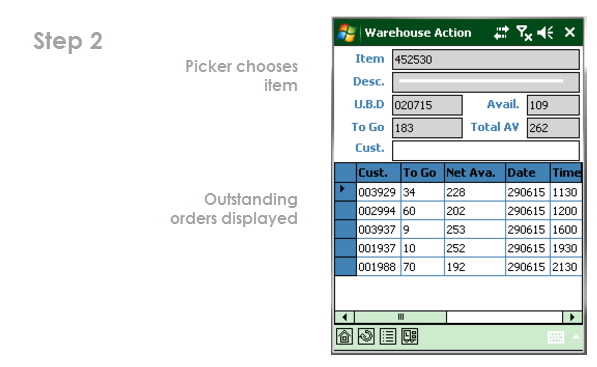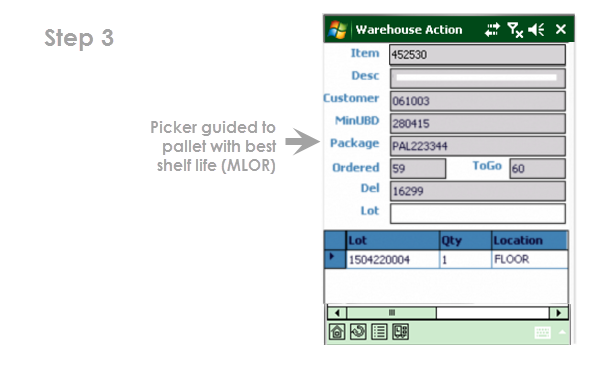Driving up Productivity in Warehouses
Oct 23 2019
Warehouse size and complexity has been fast-tracked by globalisation, increasing competition and technology improvements. Lead times are shrinking and customer expectations are higher than ever, so an efficient warehouse is critical for customer satisfaction.
Having multiple pick options is crucial to an effective and efficient warehouse – different circumstances require different methodologies. This article describes how we implemented a transformative pick methodology (without making any modifications in the ERP).
Traditional Order Picking Methodologies
Order picking is a process through which warehouse personnel pick, pack and prepare for despatch customer requirements. The main types of order picking methodologies are:
Piece picking – The picker moves through the warehouse to collect the necessary products for an order.
Zone picking – Each picker is assigned a zone and will pick the products for the order in that zone. These will then be grouped/packed in a packing area, along with other products from other zones, to fulfil an order.
Sorting systems – The products are moved along by an automatic system (conveyor) to the appropriate packing area.
Pick to box – The picking area is organised so that there are a number of picking stations connected by conveyor. The order picker fills the box with the products from their station and the box moves to the next station.
Wave picking – The picker moves to collect the products necessary for groups of orders (waves). Once again, these will then be packed in a packing area.
The Challenges of Order Picking in a Fast-paced Warehouse
During one of our recent Infor M3 ERP implementations for a FMCG fresh food manufacturer that supplies major supermarkets, the requirements challenged the traditional order picking methodologies. The company produces fresh meals with very short use-by-dates, ranging from 7 – 28 days from the production date. The major supermarkets required a minimum shelf-life on receipt (MLOR) of up to 75%, that is, 7 days shelf-life products need to be despatched within 2 days of production.
In addition to the tight shelf life requirements, the demand for these products is seasonal and varied based on consumer behaviour. For example, a consumer typically chooses meals with a later use-by-date which would lead to the supermarket having to scrap more of the expired meals than they normally would, which in turn leads to an order beyond forecast. To ensure minimal wastage (avoid over-production) and high service-levels (avoid under-production), the planning and production departments had to optimise equipment utilisation and warehouse capacity. The product was therefore produced in waves with a near on just-in-time approach with some safety stock to cater for demand variations.
In such a highly constrained supply chain, where the customer doesn’t necessarily order in full pallets, the order picking process needs to be very efficient (minimal touches of each pallet) and accurate (correct shelf-life batch picked).
Limitations of wave-picking in fast-paced warehouses
On the surface, these requirements sound like they can be easily catered for in M3 using wave-picking. But when we worked through the details, we faced the following challenges:
- One product produced per line
Some were made earlier in the day and some that afternoon prior to departure. And their deadlines were so tight that they couldn’t wait until all products were produced to commence picking a wave. - Real time orders
The customer orders are entered in near real-time during the day, so the warehousing staff would have to wait for periodic wave creation – leading to potential down-time. - Double-deep racking
Meant that hard-allocation created some issues during picking. However, they still had the requirement of picking for the correct shelf life requirements.
The wave picking concept focuses on a group of orders – you release a grouping of orders based on route (or other characteristics) and the picker then picks in the appropriate pick path. In this scenario however, a wave release wouldn’t help picking efficiency as not all products have been manufactured yet and the picker would then have to revisit the same wave multiple times after each product is produced – not very efficient. Also typically in the M3 Warehouse Management System, only one picker can action one wave at any given time.
The Solution: Dynamic Waveless Picking
For this project, the best solution was Dynamic Waveless Picking, which uses wave principles, but continuously updates production status – ensuring that pickers are always working on up-to-date information.
We used standard M3 (with some clever configuration) and the “Pick by Item” function in our warehouse mobile tool, WarehouseACTION.

Dynamic Waveless Picking in Action
In the WarehouseACTION tool, waveless picking is processed this way: When the customer orders are received and released for pick, the pick lines are then displayed on the “Pick by Item” screen, based on appropriate filters, eg., date or route.
Using the tool, warehouse managers and staff have ample visibility on the floor to prioritise the items which can be picked for the next departures.
The lines with enough stock to pick are displayed in green, lines with partial stock are displayed in orange and the lines with no stock awaiting production are displayed in red – see below.

Once the picker chooses the item to pick, the details of the outstanding orders are displayed.

Upon choosing an order, the picker is then guided to the pallet with the best MLOR. This ensures the bulk pallet is only touched once and the picker can then fulfil multiple part order picks efficiently and accurately, while respecting the customer shelf requirements.

Because we could configure the business requirements in WarehouseACTION, there was no need to make any modifications to M3, which meant the waveless picking solution is flexible and adaptable to cater for future business requirements.
Benefits of Dynamic Waveless Picking
In the right environment waveless picking will give rapid productivity benefits by increasing picking productivity and throughput capacity. There will be lower ‘straggler’ impact, and better handling of last minute orders. Importantly customer service will be enhanced because you will have better shipping deadline management.
In the case of our customer, dynamic waveless picking was ideal for handling the time-sensitive challenges of the FMCG environment. Likewise, it should be considered for any fast-paced warehouse. It will give you the ability to optimize order selection by dynamically controlling tasks and handling unexpected events based on new current conditions. Using a revolving batch instead of a wave batch, it allows pickers to work continuously, regardless of unexpected events that may slow down one worker vs another, and allows work to be dynamically re-assigned at a more even pace, or from one pick zone to another.
If you would like to understand more about how dynamic waveless picking might work at your business, or learn about the WarehouseACTION tool, please Contact Us.

Joseph Konka
Solutions Architect
Joseph Konka is one of our Warehouse experts, with experience across a diverse range of industries.


 FOLLOW
FOLLOW